Key takeaways
- Event photography focuses on capturing spontaneous moments, requiring anticipation and a good understanding of lighting.
- Choosing the right Canon camera, such as the EOS R series or 5D Mark IV, enhances flexibility and performance in various lighting conditions.
- Utilize techniques like aperture priority mode, adjusting ISO, and selecting appropriate autofocus settings to improve photo quality during events.
- Effective post-processing and organizing photos into a cohesive gallery enhances storytelling and viewer experience.
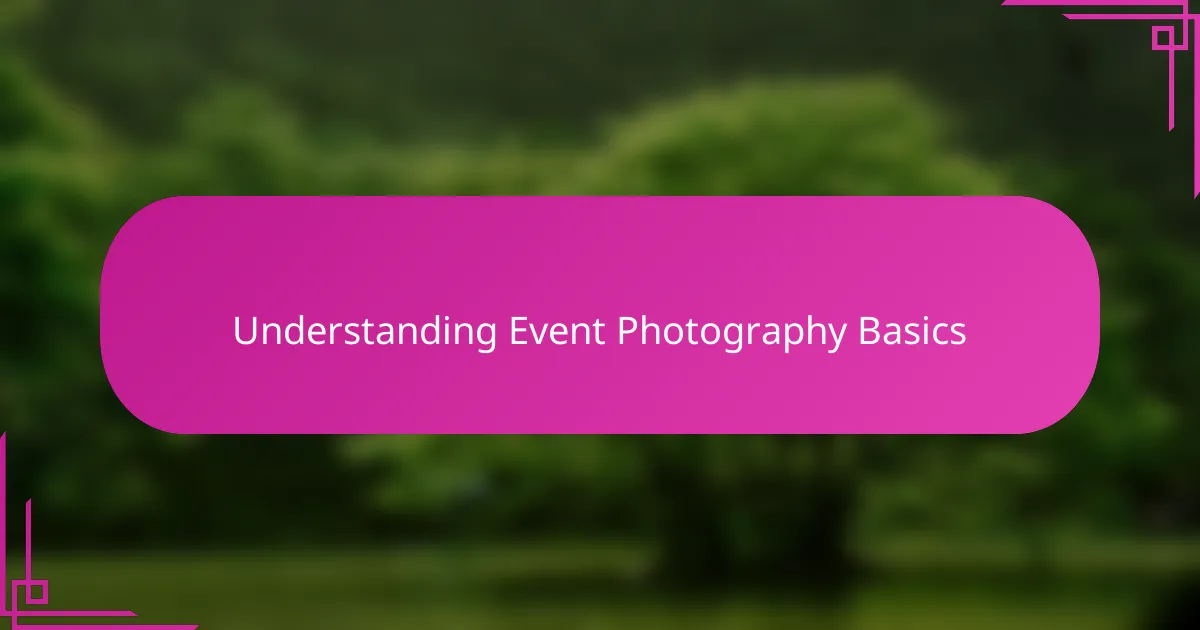
Understanding Event Photography Basics
Event photography is all about capturing moments as they naturally unfold, rather than staging every shot. From my experience, the key is anticipating those fleeting expressions and interactions that truly tell a story. Have you ever noticed how the best photos are often the ones taken when people aren’t aware of the camera?
Lighting is another fundamental piece of the puzzle. Early on, I learned that mastering available light—whether it’s the soft glow of candles or harsh sunlight—can make or break an image. It’s less about fancy equipment and more about understanding how light interacts with your surroundings and subjects.
Lastly, staying flexible and patient is essential. Events are unpredictable by nature, and you need to move quickly but thoughtfully. I often remind myself that capturing the perfect shot is a balance between being ready and letting the moment come to you—something every photographer should embrace.
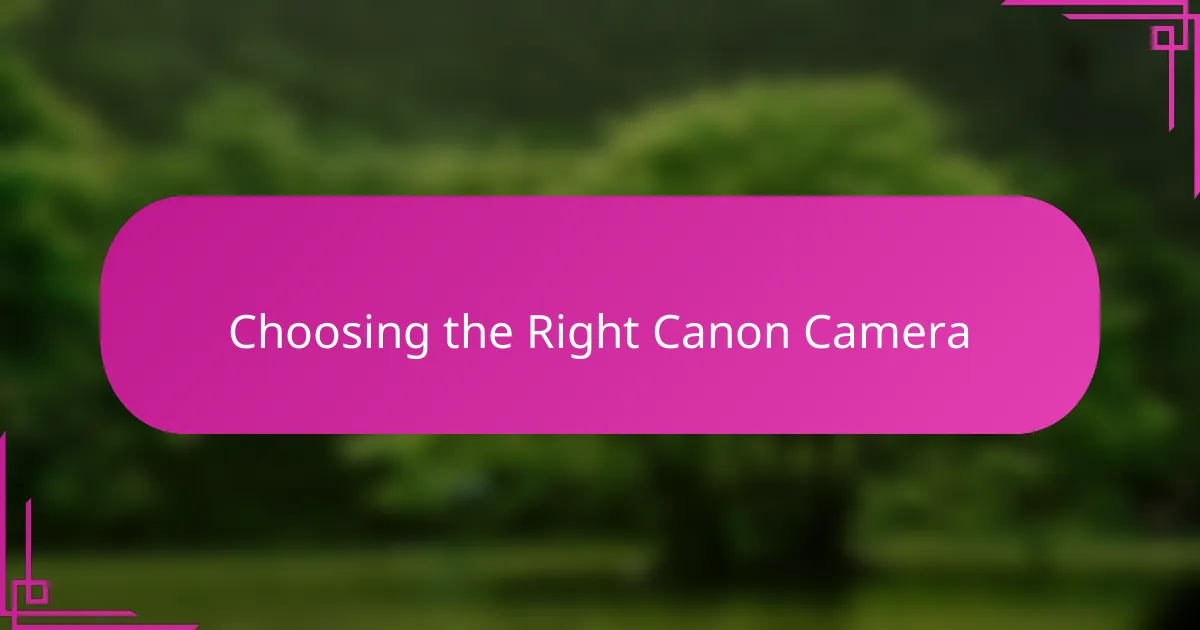
Choosing the Right Canon Camera
Choosing the right Canon camera was a game-changer for me. Early in my journey, I struggled with bulky gear that slowed me down during fast-paced events. Once I switched to a Canon EOS R series, the lightweight design and impressive autofocus made it easier to capture those split-second expressions without missing a beat.
I often ask myself, do I need the latest model or something more versatile? For event photography, I found that a camera with a reliable low-light performance, like the Canon 5D Mark IV, provided the confidence I needed when the lighting wasn’t ideal. That flexibility has saved me countless times during evening receptions and dimly lit venues.
For others starting out, it’s worth considering what matters most to your style and workflow. Is it speed, image quality, or portability? From my perspective, investing in a Canon camera that aligns with how you move and shoot in events will make the experience more enjoyable—and your shots more compelling.
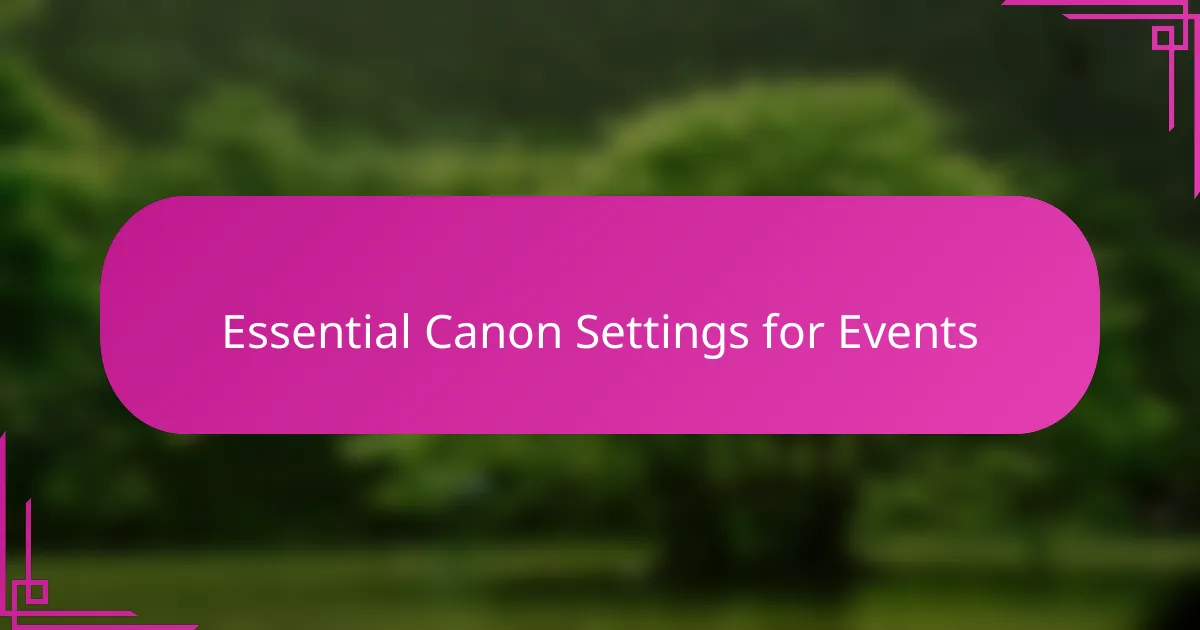
Essential Canon Settings for Events
When it comes to essential Canon settings for events, I always start with aperture priority mode. It lets me control depth of field, so I can isolate subjects against busy backgrounds. Have you ever tried shooting at f/2.8 in a crowded room? That shallow depth of field really makes your subject pop while keeping distractions at bay.
ISO is another crucial setting I adjust constantly. In dim venues, I push my ISO higher, sometimes up to 3200 or beyond, trusting the Canon sensor’s noise handling. Early on, I hesitated to increase ISO, fearing grainy images, but experience taught me that a little noise is better than missing the moment entirely.
Finally, autofocus settings are my secret weapon. I switch to AI Servo mode and select the surrounding autofocus points to track moving subjects smoothly. There’s nothing worse than losing focus on a spontaneous smile or a heartfelt speech. Using these settings, I feel confident that my Canon can keep up no matter how fast the event unfolds.
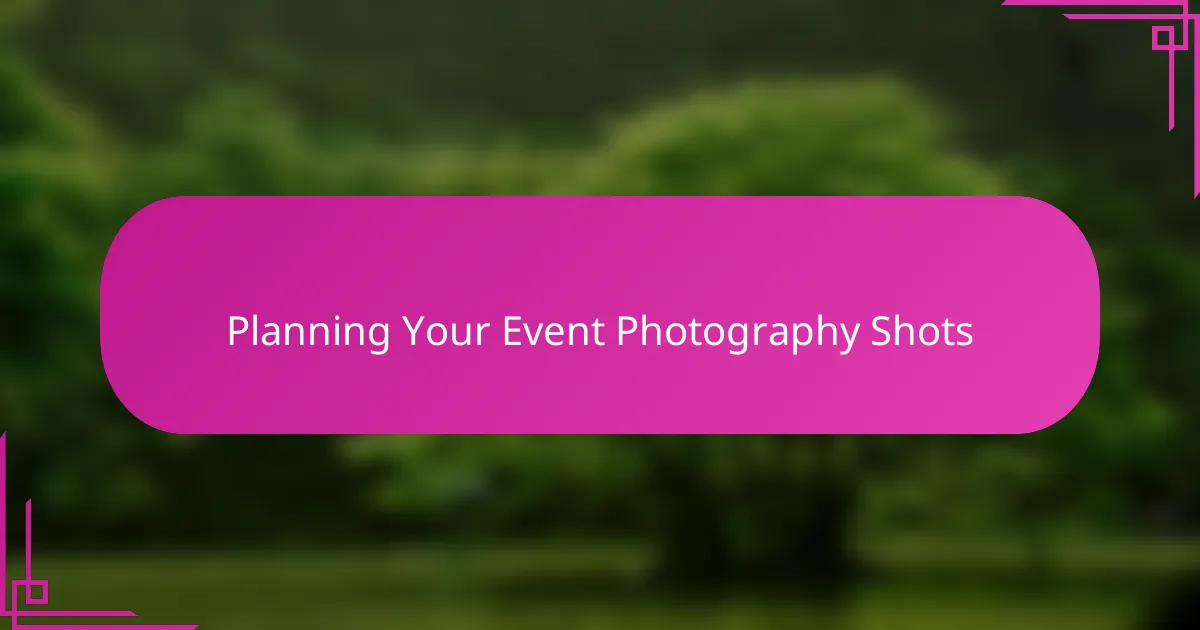
Planning Your Event Photography Shots
Planning your event photography shots starts long before the celebration begins. I always take time to walk through the venue, imagining where the key moments are likely to happen—whether it’s the entrance, the stage, or that cozy corner where guests gather. Have you ever noticed how having a mental map of your shooting spots can turn chaos into calm? It’s like giving yourself a head start to capture those natural, unscripted interactions.
I also like to consider the flow of the event and what kinds of shots will best tell the story. Will there be speeches, dancing, or candid mingling? Knowing this helps me decide when to be unobtrusive and when to step in for close-ups. Sometimes, I even jot down a quick shot list, but I’ve learned to keep it flexible—because no two events are exactly the same, and the magic often happens where you least expect it.
Lastly, thinking about lighting during planning is crucial. I recall one wedding where the reception moved outdoors just as the sun was setting; having scoped the lighting beforehand helped me adjust my camera settings on the fly. Do you plan for lighting shifts too? Anticipating these changes means you’re never caught off guard—and your images reflect that readiness.
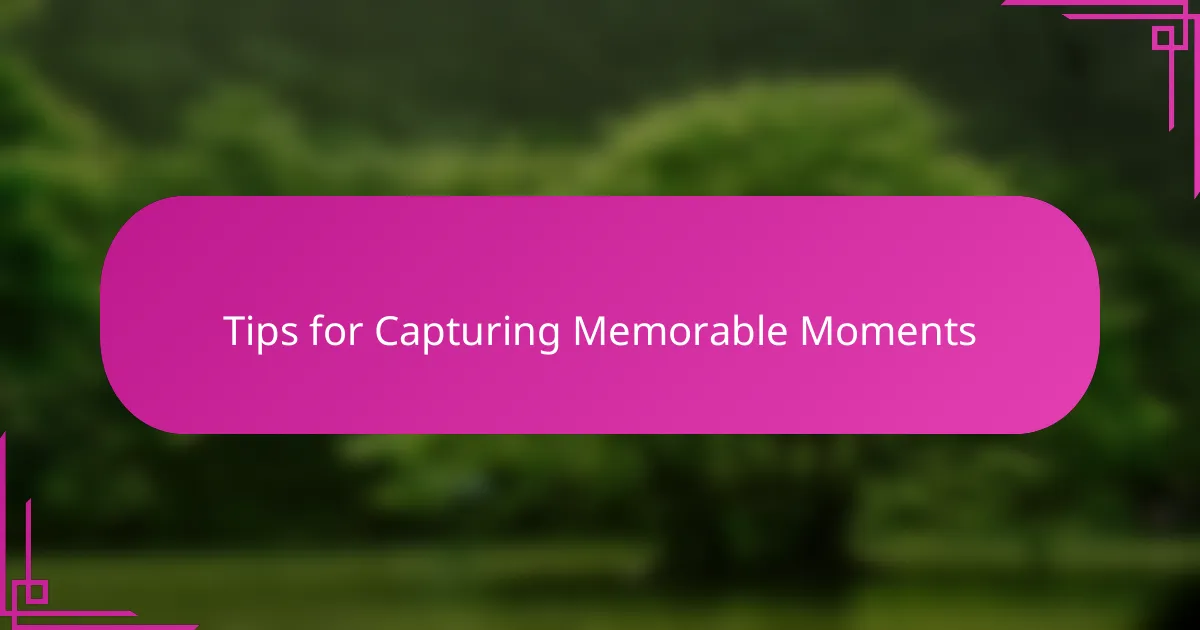
Tips for Capturing Memorable Moments
One tip I swear by is to stay present and ready, because the most memorable moments often happen in a blink. Have you ever missed a perfect shot because you were fiddling with settings? I have, and it taught me the value of muscle memory—knowing your camera well enough to adjust quickly without taking your eyes off the scene.
Another thing I’ve learned is to focus on emotions rather than just events. Capturing a genuine laugh or a tender glance creates photos that resonate long after the event ends. I remember one time during a family reunion when I wasn’t aiming at the main action but caught a spontaneous hug between cousins—and that image became the heart of the entire album.
Lastly, don’t be afraid to move around and try different perspectives. Sometimes the best shots come from kneeling down or shooting through objects like flowers or decorations to add depth. I often ask myself, “What story can this angle tell that a straight-on shot wouldn’t?” Exploring like this has made my event coverage more dynamic and engaging.
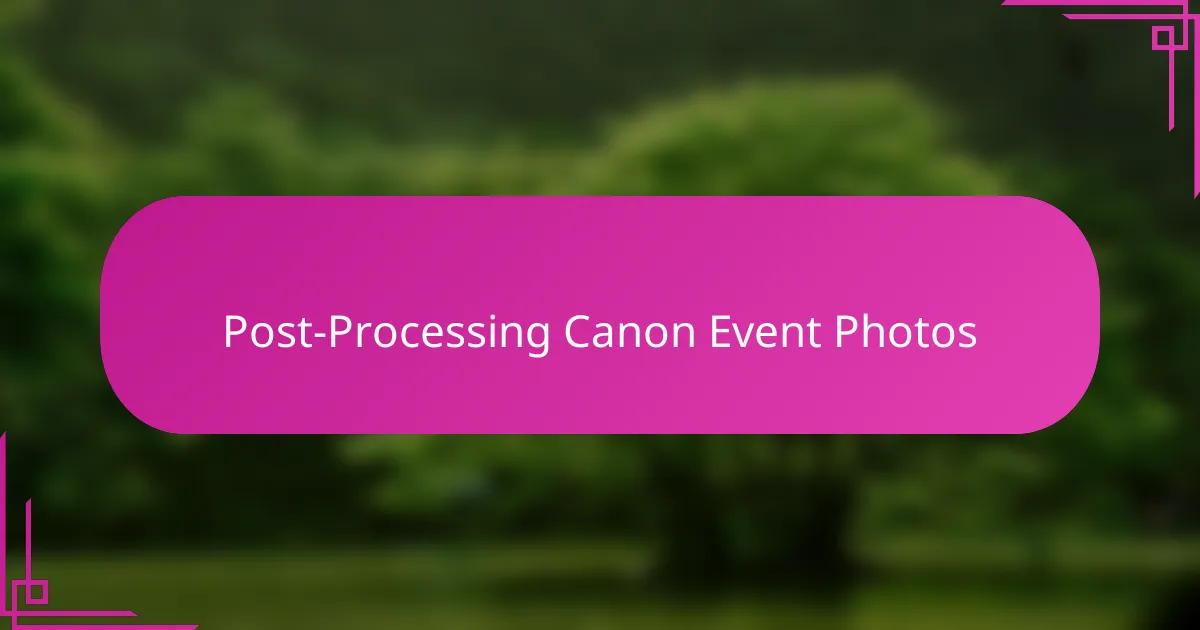
Post-Processing Canon Event Photos
Post-processing Canon event photos is where the magic really happens for me. After a long day of shooting, I find myself drawn to Adobe Lightroom to tweak exposure and bring out the subtle details that sometimes get lost in the hustle of the event. Have you ever noticed how a slight adjustment in contrast or clarity can completely change the mood of a candid moment? That’s the kind of subtle enhancement I aim for.
One of my go-to techniques involves fine-tuning white balance, especially when dealing with mixed lighting conditions like candles and fluorescent bulbs. It can be tricky, but I’ve learned that trusting my eye over the camera’s auto settings often leads to more natural, pleasing colors. I remember a wedding reception where shifting the white balance lifted the warmth of the scene, making the photos feel more intimate and inviting.
I also pay close attention to cropping and composition during post. Sometimes, an event shot benefits from a tighter frame to focus on emotions instead of distractions in the background. Isn’t it fascinating how a simple crop can transform a noisy group photo into a powerful portrait? This step often feels like storytelling in itself, helping me highlight the moments that truly matter.
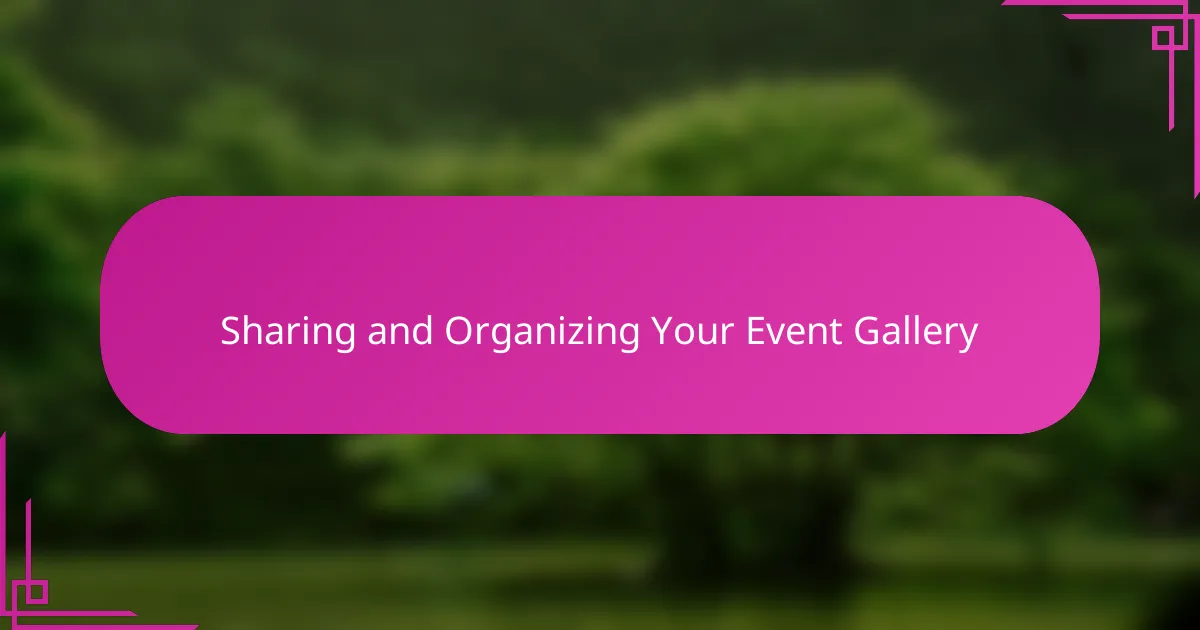
Sharing and Organizing Your Event Gallery
When it comes to sharing your event gallery, I’ve found that choosing the right platform makes all the difference. I usually opt for online galleries that allow clients to browse easily and download their favorite images. Have you ever noticed how an organized gallery can make your work feel more professional and accessible? It’s amazing how much smoother feedback and sharing become when everything is neatly arranged.
Organizing the photos chronologically or by activity can save both you and your clients a lot of time. I remember one event where I labeled folders by ceremony, reception, and candid moments — it helped me deliver a cohesive story that clients really appreciated. It’s a simple step, but structuring your gallery like this can turn a random collection of images into a compelling narrative.
Finally, I like to add clear captions or tags for special moments or key people. This little touch invites viewers to connect emotionally, making the gallery experience more personal. Have you ever gotten an email from a client saying, “I love how you captured our day”? That kind of feedback often comes when the photos are easy to navigate and meaningful to revisit.